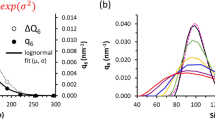Summary
Cultured rat fibroblasts were exposed to 50 fluorescent probes of varied physicochemical characteristics. Probe concentrations, fluorochrome excitation wavelength and period of illumination, and cell-probe contact time were varied. Structure-activity relationships defining a number of classes of fluorescent probes for lysosomes and related processes and compartments were demonstrated. Numerical specifications are now available for several familiar classes of probes: (a) acidotropic weak bases, used as markers for low pH compartments; (b) markers of adsorptive pinocytosis, involving non-specific protein binding; (c) markers for fluid phase pinocytosis; and (d) viability stains involving intralysosomal enzymic activity. Two novel classes of probes have also been specified numerically: (a) acid-precipitated weak acids, as markers for low pH compartments; and (b) lipid-binding markers of adsorptive pinocytosis. Overall, these structure-activity models provide a tool for predicting whether or not compounds enter cells; and whether they accumulate in lysosomes and related compartments. Pathways of entry are also predicted. This tool should permit design and selection of improved probes, and provide a better understanding of existing reagents. Moreover these models are expected to be applicable to interactions between any non-polymeric xenobiotic with lysosomes and related compartments.
Similar content being viewed by others
References
Allison, A. C. (1968) Effects of drugs and toxic agents on lysosomes. InInteraction of Drugs and Subcellular Compartments in Animal Cells (edited byCampbell, P. N.) pp 218–36. London: J & A Churchill Ltd.
Allison, A. C. &Young, M. R. (1964), Uptake of dyes and drugs by living cells in culture.Life Sci. 3, 1407–14.
Anderson, R. G. W. &Pathak, R. K. (1985) Vesicles and cisternae in the trans Golgi apparatus of human fibroblasts are acidic compartments.Cell 40, 635–53.
Bucana, C., Saiki, I &Nayar, R. (1986) Uptake of the vital dye Hydroethidine in neoplastic cells.J. Histochem. Cytochem. 34, 1109–15.
Chang, H. C. (1935) The so-called neutral red “vacuome’ and the Golgi apparatus.Anat. Rec. 62, 95–103.
de Duve, C., de Barsy, T., Poole, B., Trouet, A., Tulkens P. &Hoof, F. V. (1974) Lysosomotropic agents.Biochem. Pharmacol. 23, 2495–531.
Evans, H. M. &Scott, K. J. (1921) On the differential reaction to the vital dyes exhibited by the two groups of connective-tissue cells.Carneg. Instit. contrib. Embryol. 10, 1–55.
Gandin, E., Piette, J. &Lion, Y. (1982) Purification of halogenated fluorescein derivatives by gel chromatography.J. Chromatogr. 249, 393–8.
Green, F. J. (1990) The Sigma-Aldrich handbook of stains, dyes and indicators. Milwaukee: Aldrich Chemical Co.
Hansch, C. &Leo, A. (1979)Substituent Constants for Correlation Analysis in Chemistry and Biology. New York: John Wiley & Sons.
Holtzman, E. (1989)Lysosomes. New York: Plenum Press.
Honig, M. G. &Hume, R. I. (1986) Fluorescent carbo-cyanine dyes allow living neurons of identified origin to be studied in long-term cultures.J. Cell Biol. 103, 171–87.
Horobin, R. W. (1988)Understanding Histochemistry: selection, evaluation and design of biological stains. p. 149. Chichester: Ellis Horwood Ltd.
Lillie, R. D. (1977)Conn's Biological Stains. 9th edn. Baltimore: Wilkins & Wilkins.
Marshall, P. N., Bentley, S. A. &Lewis, S. M. (1978) Standardization of Romanowsky stains. The relationship between stain composition and performance.Scand. J. Haematol. 20, 206–12.
Payne, J. N., Cooper, J. D., Mackeown, S. T. &Horobin, R. W. (1987) A temperature controlled chamber to allow observation and measurement of uptake of fluorochromes into live cells.J. Microsc. 147, 329–35.
Perrin, D. D. (1965) Dissociation constants of organic bases in aqueous solution. London: Butterworths.
Peterson, C. A. (1979) Selective vital staining of companion cells of potato tuber and parsnip root with Neutral Red.Stain Technol. 54, 135–9.
Pratten, M. K. &Lloyd, J. B. (1983) Effect of Suramin in pinocytosis by resident rat peritoneal macrophages: an analysis using four different substrates.Chem. Biol. Interact. 47, 79–86.
Rashid, F. &Horobin, R. W. (1990a) Interactions of molecular probes with living cells and tissues. 2. A structure-activity analysis of mitochondrial staining by cationic probes, and a discussion of the synergistic nature of image-based and biochemical approaches.Histochemistry 94, 303–8.
Rashid, F. &Horobin, R. W. (1990b) Mitochondrial staining in cultured cells by non-cationic fluorescent probes. InTransactions of the Royal Microscopical Society, Vol. 1. (edited byElder, H. Y.) Chap. 13, pp. 451–4. Bristol: Adam Hilger.
Rashid, F. & Horobin, R. W. Accumulation of fluorescent non-cationic probes in mitochondria of cultured cells-observations, a proposed mechanism, and some implications. J. Microsc. (In Press).
Robbins, E. (1960) The rate of Proflavin passage into living cells with application to permeability studies.J. Gen. Physiol. 43, 853–66.
Robbins, E. &Marcus, P. I. (1963) Dynamics of Acridine Orange-cell interaction. I. Interrelationships of Acridine Orange particles and cytoplasmic reddening.J. Cell Biol. 18, 237–50.
Roberts, G., Williams, K. E. &Lloyd, J. B. (1980) Mechanism of stimulation of pinocytosis by Trypan Blue.Chem. Biol. Interact. 32, 305–10.
Rotman, B. &Papermaster, B. W. (1966) Membrane properties of living mammalian cells as studied by enzymatic hydrolysis of fluorogenic esters.Proc. Natl. Acad. Sci. USA. 55, 134–41.
Rundquist, I., Olsson, M. &Brunk, U. (1984) Cytofluorometric quantitation of Acridine Orange uptake by cultured cells.Acta Pathol. Microbiol. Immunol. Scand. [A]92, 303–9.
Serjeant, E. P. &Dempsey, B. (1979)Ionisation Constants of Organic Acids in Aqueous Solution. Oxford: Pergamon Press.
Swanson, J. A. (1989) Fluorescent labelling of endocytic compartments.Methods Cell Biol. 29, 137–51.
Windholz, M. (1983)The Merck Index. 10th edn. Rahway, New Jersey: Merck & Co., Inc.
Author information
Authors and Affiliations
Rights and permissions
About this article
Cite this article
Rashid, F., Horobin, R.W. & Williams, M.A. Predicting the behaviour and selectivity of fluorescent probes for lysosomes and related structures by means of structure-activity models. Histochem J 23, 450–459 (1991). https://doi.org/10.1007/BF01041375
Received:
Revised:
Issue Date:
DOI: https://doi.org/10.1007/BF01041375




